
Everyone knows that you need to commit time to training to hone your body for peak performance in sports and other physically demanding activities, but before you get to your workouts, there’s one pressing question: Is stretching a necessary part of that equation?
Static and dynamic stretching have long been part of training regimens for athletes of all levels. There’s still no conclusive research that proves that stretching is effective at preventing injuries, but we do know that a healthy regimen can improve joint range of motion and flexibility, which is certainly important for any sport or fast paced activity. Dynamic stretching in particular appears to help in warming up the muscles, which makes the joints more mobile, the tendons more compliant, and the body more prepared to perform a specific activity. Before you decide which regimen might be best for your training, it helps to know the difference between the two.
Static stretching is performed in a stationary position, with a sustained hold in a position that lengthens a certain muscle. According to some research, static stretching can actually have an inhibitory effect on muscle power. In other words, by lengthening the muscles and holding them in that position for an extended period of time, the muscles appear to conjure less force when tested by resistance training afterward. That leads some to argue that static stretching can have a negative impact on performance. So what about dynamic stretching?
Dynamic stretching, on the other hand, is performed while moving, often mimicking movements of the sport or activity that you plan to perform, factoring in the explosive movements such as sprinting, jumping, or cutting. Dynamic stretching creates more heat in the body and can better prepare the body for rigorous, fast-paced activity. Even swimmers often perform dynamic stretches swinging their arms around to promote mobility and readiness in their joints.
How to Decide the Type of Stretch You Need

Dougal WatersGetty Images
More and more evidence favors dynamic stretching over static stretching to help prevent injuries and loosen tight muscles. But the type of sport or workout you plan to do matters. One study found that dynamic stretching, with or without the addition of static stretching, was effective at improving sprint times in runners.
With dynamic stretching, it’s always good to target the primary muscle groups you plan to use. For most people, this means the larger muscle groups of the lower extremities such as the hamstrings, quadriceps, and glutes. The smaller workhorse muscles such as the gastrocnemius and soleus are also majorly important to activate as they help generate power and propulsion in sports such as running, basketball and football.
In activities where there is a lot of standing around followed by quick explosive movements, dynamic stretching is a great way to get the body ready for activity without needing to be in constant movement. According to one study examining jump performance in basketball players, dynamic sport-specific exercises before play can help coordinate movement and increase neural drive, helping the body more easily transition from the eccentric to concentric phases of muscle activation.
Dynamic stretching helps set up your brain and your body for healthy movement patterns that are specific to your sport. They can help improve range of motion and flexibility at a joint, two things you need for successful movement. Even while the research can’t promise that dynamic stretching will prevent injury, it does seem to be effective at improving performance without doing any harm. So, when it doubt, stretch it out.
Check out these dynamic stretches to perform to get ready for your next workout. Just remember that you’ll want to match the exercises you incorporate to the ones that most closely resemble the activity you are about to perform.
Lower Body Dynamic Stretching Routine
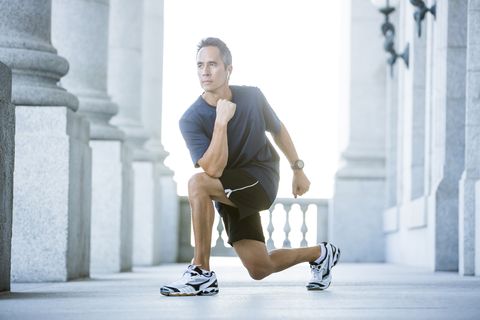
Mike KempGetty Images
Hamstring Scoops
10 steps
Begin with one leg straight in front of you with the heel touching the ground and toe turned upwards. Bend down scooping your hands along your body and following the length of your leg until you return to standing. Repeat this movement pattern for 10 steps, alternating sides.
Leg Kicks with Opposite Arm Reach
10 steps
Kick one leg out straight in front of you while reaching for the toes with the opposite hand. Walk alternating which leg kicks forward, incorporating the opposite arm reach with every step. Repeat for at least 10 steps.
High Knees
1 minute
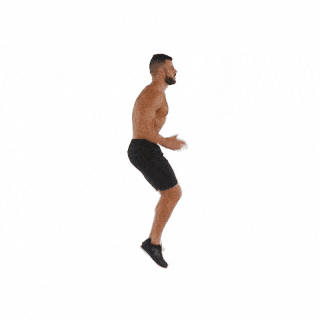

Men’s Health
Begin by jumping in place. Lift one knee up to hip height before rapidly switching to the other side like you are marching in place. Quickly alternate from side to side for at least one minute.
Squat Jumps
30 to 60 seconds
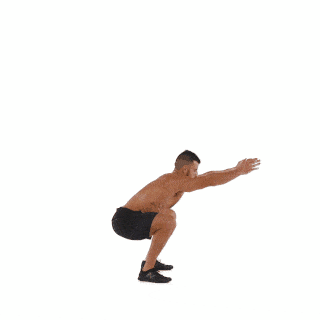

Men’s Health
Begin in a standing position. Squat down toward the ground before explosively jumping into the air, lifting both knees to your chest. When you return to the ground, perform another small squat before jumping again. Repeat this movement pattern for 30 to 60 seconds.
Butt Kicks
10 steps
Walk quickly, performing small hops as you alternate quickly bending one knee until your foot makes contact with your buttock. Repeat alternating sides with each step for at least 10 steps. You can stay in place or travel.
Upper Body Dynamic Stretching Routine
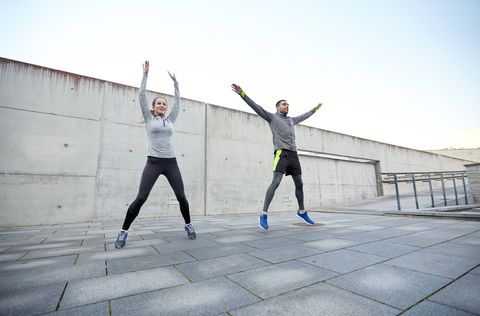
dolgachovGetty Images
Walking Lunge Twist
10 steps
Begin standing with arms clasped behind your head. Step forward into a forward lunge, going down to one knee. When in the lunge position, rotate your upper body towards the side of the knee that is in front. Perform 10 of these alternating sides and direction of the twist with each step.
Arm Circles
30 to 60 seconds
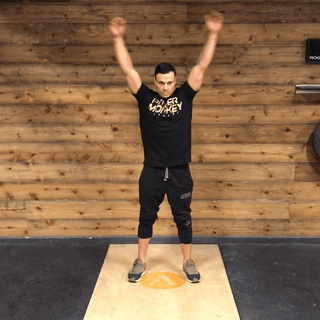
Men’s Health
Bring your arms out to the side like you’re making the letter “T” then make circles with your arms. Begin with small circles in one direction, then increase the size of the circles. Repeat in the opposite direction. Do this for 30 to 60 seconds.
Plank Walk Out
10 reps
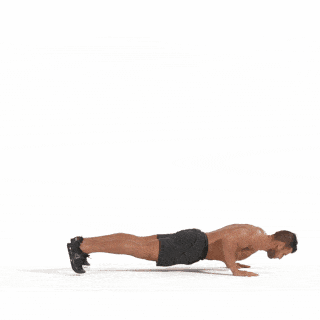

Men’s Health
Start in a standing position. Drop down to your hands and walk the arms out into a plank position. You can perform a push up or simply walk yourself back to standing after the plank. Repeat for 10 reps.
Jumping Jacks
30 reps
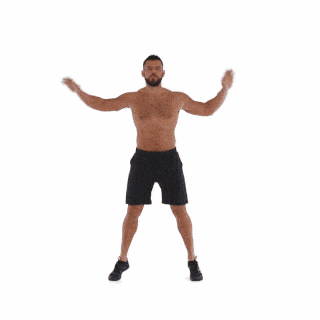

Men’s Health
Start in the standing position with arms by your sides. Bring arms over head as you jump and straddle. Return arms to starting position. Repeat at least 30 times.
Arm Hug
30 seconds
Begin in standing. Quickly alternate between hugging your chest and reaching your arms out to the sides, opening and closing your chest. Repeat for 30 seconds.
Source: Read Full Article